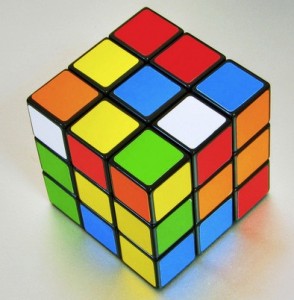Of course you have!
We continuously bump up against obstacles that stand between us and what we need or want.
Whether we realize it or not - we’ve become adept at working around these barriers using everyday problem solving skills.
When our kids were little, we paved the way for them to get what they needed. Even now - they may not be aware of the obstacles we clear from their path.
But as they grow, we realize that our kids must learn skills to solve daily problems on their own.
Problem solving is a multi-step process that requires instruction and practice. Let’s look at how we can teach our kids a simple strategy for solving everyday problems.
The steps to solving a problem
Although the process can be broken down into many sub-steps, it is generally agreed that problem solving involves these basic components:
- Define the problem
- Identify several potential solutions
- Evaluate each alternative
- Choose a solution
- Implement the solution
- Evaluate results
- Choose a different solution or seek help if results are not satisfactory
As adults, we may not even be conscious of going through these steps. They have become our automatic response to the everyday problems that arise in our lives.
The good news is that even kids who have intellectual disabilities, or disabilities that impact attention or self-regulation - can learn to do this, too. But we’ll need to explicitly teach them.
(Note - today we’re talking about simple everyday problem solving. For larger problems involving longer-term solutions - we need to plan out our actions over time using an Action Planning strategy.)
Using a graphic organizer
A simple graphic organizer can effectively guide a learner through a multi-step process.
You can download a free problem solving graphic organizer here.
After many successful practice opportunities using the graphic organizer, learners develop the habit of following the steps when confronted with a problem. (The number of practice opportunities needed to reach automaticity will vary widely among individuals).
Understanding the steps
Let’s look at each of the steps on the graphic organizer.
The Problem
Teach your child to define the problem using “I” language. This helps lead to potential solutions.
The problem is NOT - “My teacher is mean”. (Even if this is true, there’s nothing your child can do about it.)
The problem IS - “I want to play video games but I have homework tonight.” (This is a problem for which potential solutions can be generated.)
Teach your child to define a problem using this format:
” I need (or want) ___________, but ______________.”
Potential solutions
Teach your child to identify at least three potential solutions to the problem before evaluating the pros and cons of any option.
At first, she’ll find this difficult.
Kids (and too many adults) often act on the first option that comes to mind. Your child will likely need much modeling from you and a lot of guided practice before being able to identify multiple potential solutions.
Use the graphic organizer to model for your child how you identify several options before evaluating each one.
Pros and Cons
After listing at least three potential solutions - your child should identify at least one “pro” and one “con” for each option. This is another step that he may find challenging.
First of all - we’ll need to explain and demonstrate the meaning of “pro” and “con” - with lots of examples.
We must also understand that kids find it difficult to see the “cons” of a preferred solution. This is especially true if the “cons” involve impact on other people and/or personal consequences that are long term rather than immediate.
Since kids don’t have much practice evaluating the potential consequences of actions - they will need many opportunities to practice this step, with modeling from us. Use the graphic organizer (again and again) to demonstrate for your child the pros and cons of potential solutions to your own problems.
Choose and try a solution
Teach your child (through modeling using the graphic organizer) - how you choose solutions that will most likely solve a problem with:
- the time and resources available
- minimal (or no) negative impact on yourself or others (now or in the future)
Once a solution has been chosen - it’s time to act. Will the solution be implemented immediately? If not - when and how?
Did it work?
As you model problem solving with your child using the graphic organizer - explain how you will know if the solution was successful. Demonstrate how - even for you - there are times when the chosen solution doesn’t solve the problem as planned.
The next step is not “Give up”!
Use the graphic organizer to show how you make the choice to either try another identified solution or seek help at this point in the process.
I Do - We Do - You Do
Research shows that effective explicit instruction for any skill involves:
- Demonstration (I Do)
- Guided Practice (We Do)
- Independent Practice with Supervision (You Do)
Applying this to problem solving, you can use the graphic organizer to:
- Demonstrate how you use the steps to solve your own everyday problems, (“I Do”), then
- Work the process with your child to solve problems important to her (“We Do”), then
- Be present as your child uses the graphic organizer to solve problems (“You Do”)
Let your child know that the graphic organizer shows the steps that you go through “in your head” to solve everyday problems. Assure her that, with enough practice, she will learn how to take these steps “in her head” to solve her own everyday problems.
Let her know that it takes lots of practice for anyone to be able to do these steps without the graphic organizer.
Here’s an example of an everyday problem to model with your child using the graphic organizer:
Problem - I want to bake chocolate chip cookies but I have no eggs
Solutions - I could :
- drive to the store to buy eggs
- borrow eggs from a neighbor
- look for recipes without eggs
Pros/Cons
Drive to store
- Pros - will have eggs for recipe
- Cons - Don’t have enough time, will use gas (expensive)
Borrow eggs from neighbor
- Pros - will have eggs for recipe
- Cons - Don’t want to bother neighbor at this hour
Look for another recipe
- Pros - if I find one without eggs - can bake cookies
- Cons - will take some time (not too much), and I may not find a cookie recipe without eggs
Choose and implement solution
I choose to look for another recipe because it won’t take too much time if I use Google - and I might find a recipe without eggs.
Evaluate solution
The eggless cookie recipes require other ingredients we don’t have, so this solution doesn’t work.
Choose another solution
After reviewing the other two solutions, I decide I’m not willing to accept the “cons”.
So - I ask myself - what dessert ingredients do we have? I find we have the ingredients for apple crisp - so we will make that recipe instead.
Note:
The problem was a small everyday problem - not a contentious, emotional, big problem. It is generally best to model and practice using the graphic organizer with small problems of this nature. In this way, you and your child can focus on the steps of the process without being distracted by strong emotions.
Taking the time
The steps listed above could take place in your head in a moment or two. But what would your child learn from that?
It takes time and intentional effort to bring out the graphic organizer and demonstrate the process with your child.
Your child may need many demonstrations with many problems, and then many opportunities to practice using the graphic organizer with your support.
Some parents and teachers engage kids in a “problem of the day” with the graphic organizer for 15-30 minutes a day for months before they are able to generalize the process to problems without the graphic organizer.
Your life is busy as it is. You need to set priorities.
Problem solving is a skill that will have a BIG impact on your child’s quality of life. If you are ready to start teaching these skills now - great!
If there’s no time in your life to add a new routine at this point, you can mark a date in your calendar and re-consider your readiness to begin at that time. Or you may want to consider if another family member, mentor or teacher could take the lead in teaching your child problem solving skills (with your support).
Your turn
What’s your reaction to this structured method of teaching problem solving skills? Do you think it makes sense for your child?
We’d love to hear your questions or comments below. Or - feel free to send me an email by clicking on the white envelope in the sidebar.
All the best to you and your child in the daily adventure of navigating life’s ups and downs with joy.
Did you find this post helpful? Please share it! Thanks!
Photo credit: hermanturnip at Flickr





{ 2 comments… read them below or add one }
Time is so important, as is the opportunity to fail and try again. Thanks!
Thanks for your comment, Sue. I’m always thrilled when I get emails from teachers or parents who are using the graphic organizer to teach problem solving. It often takes lots of modeling and guided practice - but what a difference this powerful skill can make in a young person’s life! I really appreciate you taking time to comment. All the best!